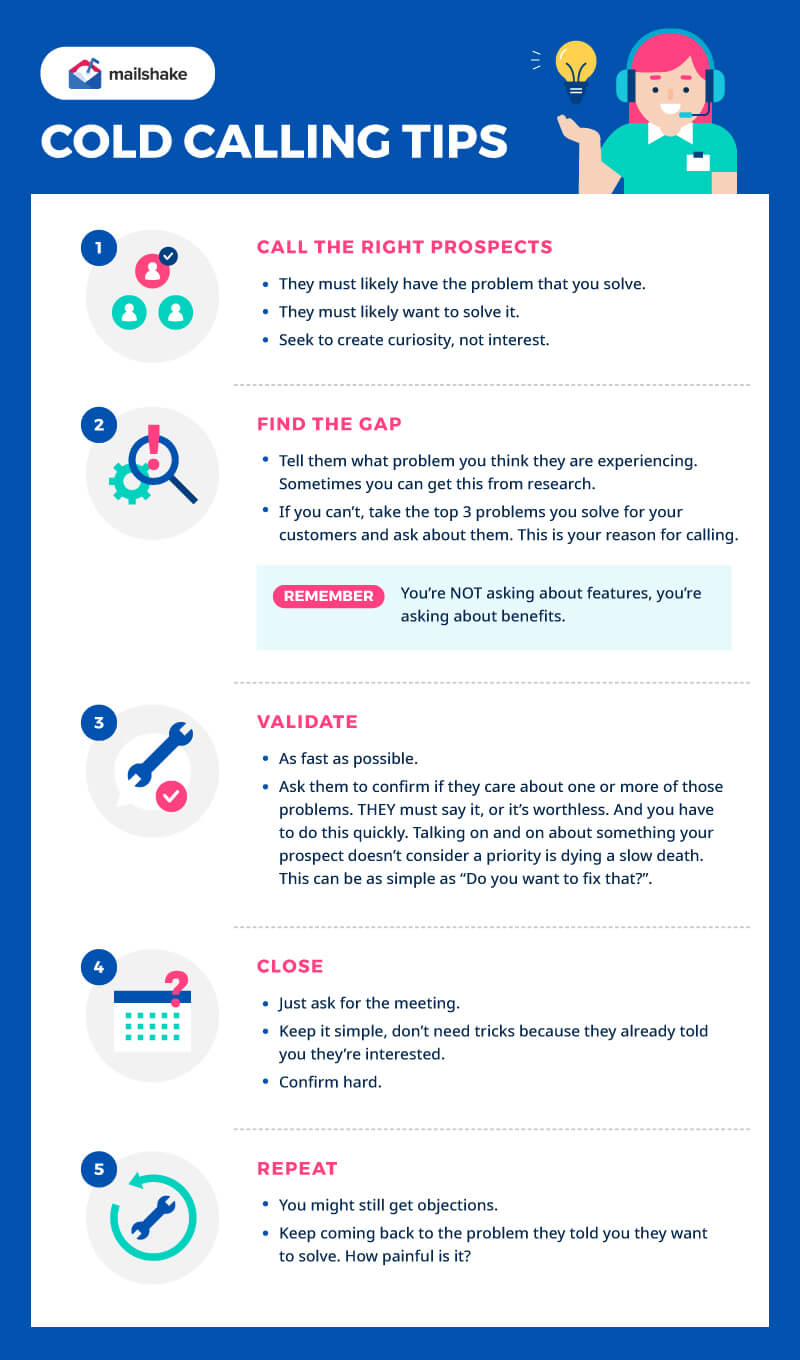How to Create Your Own Sales Cold Calling Scripts

Contents
Cold calling is challenging enough, but finding a cold calling script that’s not only effective but also specific to your business can be downright impossible.
Rather than combing through endless Google searches or dozing off skimming a cold calling guidebook, you should simply create your own. That’s what we’ll talk you through in this article, thanks to input from Wendy Weiss of ColdCallingResults.com and Derek Jankowski, director of sales development at PatientPop.
Why Cold Calling Scripts Are Worth Creating
You might think cold calling scripts just aren’t for you. That they’ll stifle your team’s natural creativity and ability to think “on the fly.”
But that’s simply not the point of creating a sales script. This isn’t about transforming your salespeople into a bunch of unthinking robots, churning out the same conversations over and over again.
Instead, it’s about giving them the tools they need to have consistently valuable discussions with prospects. Tom Brady might be the best quarterback of all time, but he doesn’t just invent his plays off the cuff – they’re drilled into him through hundreds of hours on the training field.
As Wendy Weiss puts it: “A lot of people will say ‘I can’t use a script, I can’t be myself, it’s phony’. But if you think before you speak, that is a script.”
After all, every sales rep has a go-to introduction, or an elevator pitch they come back to time and again. And they’ll have standard responses to common questions. So in essence, they already have a script – all you’re doing is making it better.
Pre-call Prep
You probably don’t pick a new restaurant without doing some research first, right? So why would you do one of your most important business-building tasks without doing some prep work first? The answer is, you shouldn’t.
What’s the goal of your call?
Start by defining the goal of your cold call. Most likely, it’ll be to secure an appointment – whether that’s an in-person meeting, a Zoom video conference, or a more in-depth phone call.
Equally, Wendy notes, it’s important to define what doesn’t qualify as an appointment. “One of the things that it doesn’t mean is that you’re getting your prospect’s agreement to dump their vendor and hire you. You’re not asking them to make a buying decision or a hiring decision.”
Consciously or not, salespeople often make the mistake of using overly salesy language on an introductory cold call.
“They may not mean to use this language or realize how the prospect hears it,” Wendy explains. “But it sounds like they’re asking them to make a buying or hiring decision, and they’re not going to do that. Not over the phone and not in a 2-5 minute phone call.”
Build a list of prospects
As obvious as it sounds, you only want your sales team to be calling genuine prospects. Anything else is a waste of time.
But what actually is a prospect?
Derek Jankowski uses this definition: “A prospect is someone who WANTS to solve the problem you solve.”
He recommends running through this simple template to build a prospect list that ensures your team is speaking to the right people:
- What problem do we solve?
- Why do I believe this prospect has this problem?
- Why do I believe this prospect wants to solve this problem?
That final point is easy to overlook, but it’s really important. Let’s say your company sells accounting software that automates the process of sending out and chasing up invoices. You might find someone who wastes a big chunk of their working week on invoicing – but if they don’t have the time, energy, or motivation to do something about it, they’re not a prospect.
Find the gap
Even when you’ve identified both a need and a desire for your product, you still need the prospect to confirm that they want it.
Derek recommends treating this part of the process as a game of disqualification: “How quickly can I get this person out of this step of my pipeline? They’re either not a prospect and they’re out, or they are, and I move them forward.”
To do this, start out by telling them about the problem you’ve identified. If you’re an SEO agency, you can tell your prospect that their site is poorly optimized (and why that’s important). Or, if you don’t know for certain that the problem exists, you can give them some industry statistics – X% of companies in your industry struggle with this – or offer some observations based on information you’ve found on their website, in their marketing collateral, or in a blog post.
Writing Your Cold Calling Script
With defined your pre-call process, it’s time to consider the various elements that go into a successful sales script.
Broadly, keep in mind what your prospect wants to hear when you cold call them. Tell them who you are and what you want, and use this to frame the script. Specifically, it should look a little like this:
Identify yourself and why you’re calling (fast)
It’s safe to assume your prospect is a busy person, so give yourself no more than 10 seconds to give your introduction.
The average person speaks at a rate of about 130 words per minute, so that gives you no more than 20-30 words to state your purpose. Your goal is to form a bond quickly, so use your research to inform the best possible opener.
For example:
Touch on their pain points
“Now that we’re in Q1 and your busy season is behind you, I wanted to reach out and talk to you about our software. Switching could save your company thousands of dollars each year by automating your processes into our all-in-one solution, giving your clients a way to pay online, and cutting your staff’s workload in half by going paperless and streamlining your marketing process.”
Sell your value early
“The reason I’m calling is that we just saved Acme Supply Co an additional $450,000 a year in warehousing and shipping costs. I thought that was significant enough to warrant a phone call between us to see if we can replicate that same success for your company.”
Validate the gap you identified in your pre-call prep
Use Derek’s advice from the previous section to create the perfect question to validate a need for your product, then pique their interest further by selling through curiosity.
Don’t give them the opportunity to say yes or no. Instead, ask open-ended questions to get them talking and keep them talking. People love to talk about themselves, and the more you learn about them and their business, the more likely you are to get the sale.
A study by Gong found that asking 15-18 questions over the course of your discovery call is only marginally more effective than asking 7-10. Try having a list of around 11-14 questions prepared for your call.
Be sure to highlight questions relating to their pain points and goals, such as:
- What are your goals for this quarter?
- What problem are you attempting to solve?
- What would a successful outcome look like?
The course of a cold call rarely runs smoothly, so plan for pushback and try to predict likely objections. You want to set the call up for success by planning for as many scenarios as possible.
Acknowledge customer objections
The key is to acknowledge their objection, then redirect with a qualifying question or a value statement. A question will help dig up challenges and find an issue or pain point you can match with your product or service. A value statement doesn’t list your product’s features. Instead, it demonstrates how one of your product’s benefits solves a challenge or pain point the prospect faces.
Some common objections you’ll hear are: “Are you a telemarketer?” or “Is this a sales call?” In response, you can either:
- Redirect with a question: “I’m not looking to sell anything today. I’m calling because I’m curious as to what [service or product] you use currently to [complete a task relevant to their job]?
- Redirect with a value statement: “I’m not selling anything today. All I want to do is send you some information on how [value statement related to solving a pain point they have].”
As you get more calls under your belt, you’ll get better and better at fielding these common objections. As you hear new objections, you should write them down so you’re better prepared for your next call.
Prepare for rejection
You should also prepare for a flat-out rejection. As a last-ditch effort, show them your integrity and say something like “You’re right, maybe my product isn’t a good fit for you.” Sometimes if the call isn’t going well, this sort of statement can be disarming and be what finally gets them to lower their guard and truly consider your offering.
Finally, what separates the truly successful salespeople from the rest is that they don’t leave the call with nothing. Even if the product isn’t a good fit or the prospect is too busy, they find something to take away from the call.
Here are a few examples of common takeaways:
- Ask if you can follow up another time in the future. If so, when?
- Ask why they aren’t interested so you can be better prepared for the next call or so you can better sell to them in the future.
- Ask if there’s anyone else at their company or in their industry that might be interested in what you’re offering.
Keep in mind that rejection isn’t necessarily a bad thing – as Derek explains, your goal at this stage is to get them out of your pipeline as quickly as possible.
Give your value proposition, credentials, and examples
Having validated the prospect’s need for your product, it’s time to get across the value that you offer in user-friendly, jargon-free terms. Speak like a human, not like the value proposition your marketing department have written.
Don’t talk in vague terms; give specific credentials and examples of how your product has helped similar companies to overcome similar challenges. “Remember, you’re the only one with those stories,” Wendy says. “Those are very powerful and they’re very big differentiators. So tell your story, quickly. This is two or three sentences – it’s not War and Peace.”
Close by asking for an appointment
If your prospect is still on the phone by this point, there’s a fighting chance they’ll agree to your original objective of arranging an appointment for a more in-depth discussion.
However, there’s still plenty of time for things to go wrong. Keep your “close” simple, only asking your prospect to make one decision at a time.
According to Derek, once the prospect confirms that they want to solve the problem, your reps should respond by saying: “Okay, let’s set aside some time to talk about that and see if we can help you.”
There are two likely responses to this statement:
- They’ll agree to the meeting; or
- They’ll give you an objection.
“Either way, it’s a win,” Derek notes.

Best Practices for Creating Your Cold Calling Script
Here are some best practices to follow when creating your own cold calling scripts:
Get permission
Getting permission is the name of the game, according to Seth Godin. “Permission marketing is the privilege (not the right) of delivering anticipated, personal and relevant messages to people who actually want to get them,” he says.
He’s absolutely right, too. Nobody owes us their time, their attention, or their business. This applies to marketing, sales, and every facet of your business. The best way to get permission and earn prospects’ attention is to treat them with respect. As Seth says, “Permission is like dating. You don’t start by asking for the sale at first impression. You earn the right, over time, bit by bit.”
Don’t reinvent the wheel
Instead, research sales call scripts, and steal like an artist. Find what might be useful and relevant to your business, make it your own, and ditch the rest. Rinse, repeat, and through trial and error, you’ll build a truly unique sales script over time.
Include time for relationship-building extras
Make time to find common ground to bond over, because people prefer to say yes and buy from those they like. Ask about prospects’ kids, their alma mater, favorite sports teams, where they’re from, etc. A little small talk or a personalized gesture can go a long way towards gaining a customer.
Permit yourself to deviate from your script
It keeps you from sounding like a robot. Try using bullet points throughout your script so it doesn’t sound like you’re reading from a script. Really listen to the customer and have a genuine conversation instead of plowing through each point.
Test different ways of delivering your pitch
Don’t treat your cold calling script as the finished article. You should always be looking for improvements and iterations.
One of the best ways to identify potential improvements is to A/B test variations on key elements of your sales script. For instance, craft different one-line descriptions of your product and trial them to see which resonates best with your prospects.
To do this, you’ll first need to define a system of regular evaluation. Divide your reps into two teams, each using a different script, and get them to input their feedback into a spreadsheet after each call. Ask them to base their ratings on several criteria, such as:
- Did the prospect actively participate in the conversation?
- How often did the rep have to deviate from the script?
- How confident are they that it would help them to book a follow-up appointment?
And don’t neglect the most important metric of all: what percentage of calls ended with an appointment being booked?
One key point here: the variant scripts should be identical, with only one element – such as the product description, or introductory speech, or closing question – altered each time. This way, you can build a script that contains all the best elements from each test.
Creating a cold calling script isn’t rocket science, but it does take some finesse and determination. Your work is never really done, either, so keep testing different variations and adding common objections until you have a battle-tested script that works more often than not.
Finally, don’t forget to follow up repeatedly. Persistence is vital with cold calling – remember, 80% of sales require five follow-ups after the initial contact.





